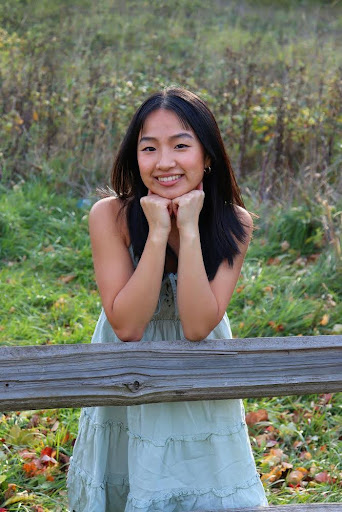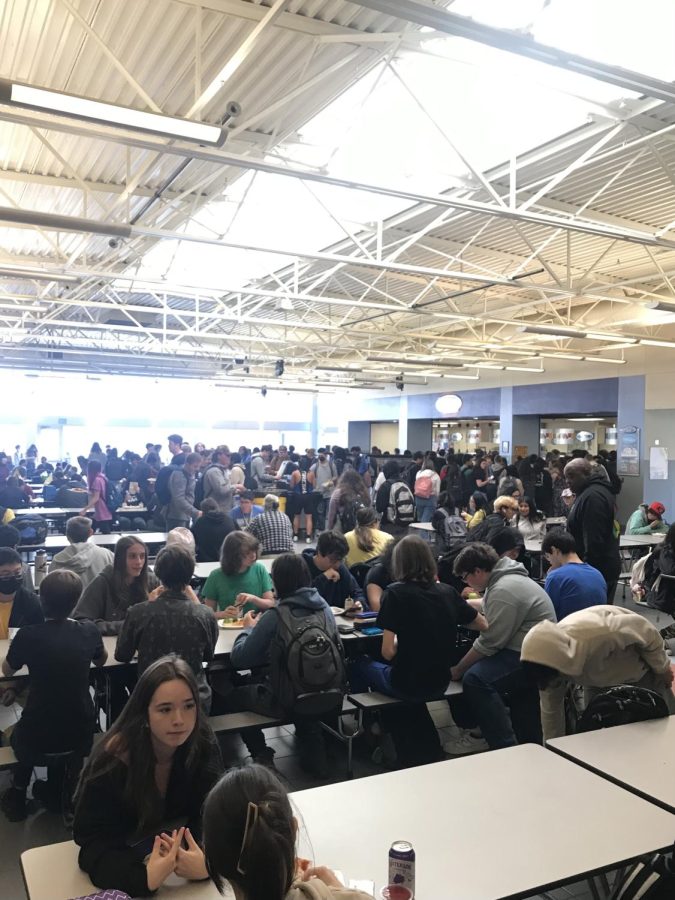On Thursday, Mar. 20, over 50 journalism students distributed their long-awaited Cub Edition to the entire school. A few hours later, the newspapers were sitting in a large stack on a chair in an assistant principal’s office. What followed showcases what responsibility and integrity look like in the real world.
Cubs learn to hunt for the truth
Two weeks prior to circulation, sophomore Isamar Alvarez, the Cub managing editor for the third period journalism class, asked the Argus editorial board to read over a story that one of her Cub reporters submitted.
Freshman reporter Declan Higgins had pitched, researched and written a news story titled, “Students find violent methods to blow off steam and stress on weekends.” It was still in the early stages of development, but he had drafted a piece that informed the community about how a group of students were hosting unsanctioned boxing matches in their basements. Higgins wrote it as a traditional news story, which consists of informing the reader of the who, what, when, where, why and how of a given situation.
“When [Higgins] came in with the GHS fight night story on the second day of pitch, I was shocked. I wanted to know what it was all about,” Alvarez said.
Higgins wrote the story with anonymous sources, a common journalism practice when dealing with sensitive or potentially incriminating material. As a journalist it is his right and responsibility to protect their anonymity.
“I told him if he can give me names and good information I would stand behind his story,” Alvarez said.
Journalism students learn about press law, first amendment rights and ethical responsibility in J1-2. This story required Higgins and his editors to take the steps that professional journalists would.
While developing the story, Alvarez and Higgins made sure to double-check each step they took by consulting with the Student Press Law Center (SPLC). When speaking to the SPLC, Alvarez was assured that they had the right to not disclose their sources.
Alvarez recognized that the content could be controversial, so she sought the advice of Editor-in- Chief Jacelyn Davis and online managing editor Rachel Spooner.
They were both appalled that the activity was happening, but agreed that it was necessary to publish because it showed how much stress some students were under.
One role of a student newspaper is to be a historian of the school and create an archive for future generations. In the newspaper staff’s eyes, this incident was necessary to document because it was a reflection of the conditions some students were under and lengths they would go to to relieve stress.
They also agreed that the article could even have positive impacts by potentially starting conversations between students and their parents or teachers about stress and methods of coping.
They knew this was part of being a public forum, and all were well aware that the article might cause controversy and felt prepared to deal with any backlash by defending their decisions and those of the reporter.
The paper hits the stands
During third period on Mar. 20, the Cub reporters circulated the papers to all the classrooms. Exhausted from a month-long project yet elated by the product all of their hard work, they discussed their favorite stories and pages while celebrating with donuts.
*****
In the main office, staff started reading over the paper, perusing the content as usual, when assistant principal Danelle Heikkila did a double-take at the story on top of the back page. Minutes after landing in their hands, the newspaper was a hot topic of discussion.
“At first I was horrified something like this was happening,” Heikkila said.
She then realized it would be part of her due diligence as an administrator to investigate this issue further and brought the article to principal John Koch’s attention, who was away at a conference that day. She read the article to him over the phone, and both were worried about the effect the story would have on students.
“The article seemed to be promoting an illegal activity,” Heikkila said.
According to Heikkila and Koch, they based these beliefs on the fact that the author did not include information that would inform readers that fighting is illegal and dangerous. They were also concerned because nowhere in the piece did it include the penalty for minors fighting or the possible damage associated with head injuries.
Student resource officer David Hickey stated that any person engaging in combat is committing some degree of illegal action. Charges range from harassment to assault two, which is a felony.
“It doesn’t matter if it’s minors or adults, it’s always illegal,” Hickey said. “Oregon law sees it as assault. We decide who the primary aggressor is, and they get arrested. Anybody who encourages a fight can be arrested for conspiracy.”
Hickey also referenced an altercation that happened a few years ago, where a fist-fight ended with a fatality and someone being charged with manslaughter.
Examples like this inform students that any violent event could have tragic outcomes.
The administration was worried that without interviews like this that students might take the article home over Spring Break and determine that starting a “fight night” of their own would be a fantastic idea.
Heikkila, Koch, as well as assistant principals Tim Collins and Aki Mori and office manager Donna Matteson, discussed the article and decided to pull back the newspaper based on potential dangers it may inflict upon students, such as inciting further violence.
They sent out an email to all teachers asking them to bring their copies of the paper down to the office. Within the hour, half of the 1,500 papers were sitting in Heikkila’s office, with more coming in from the classrooms.
Down the hall, the Argus editorial board soon found out that the admin team was pulling the papers.
“I was mad and sad, and all my emotions were running wild,” Alvarez said. “I seriously wanted to cry when Mr. Walker handed us that paper back. I was just thinking of all the other J1-2 kids, and them working so hard, and now no one was going to see their work.”
After the initial outrage over their first amendment rights being allegedly violated, the ed board knew that keeping a level head was essential when dealing with and talking to school administrators.
Nearing the end of the day
After school, the four members of the editorial board (print managing editor Kendra Taylor and associate editor Olivia Decklar, as well as Davis and Spooner) plus the two Cub managing editors (senior Brenda Alvarez and sophomore Isamar Alvarez) compiled all the Oregon laws regarding student publications and censorship.
They scrambled in that next half an hour to get as much documentation as they could to support their right to publish the piece. They gathered information about open forums, censorship, student-journalist rights and even precedent cases like Hazelwood vs. Kuhlmeier that referenced first amendment rights in schools.
Once they did that, they went to meet with Heikkila and Mori to talk about what happened.
Heikkila and Mori explained their concerns, as did the editors, but on both sides, emotions were high. Each used legal reasoning to defend their decision, so this quickly became a complicated issue.
Heikkila claimed that there was implicit bias in the story in favor of the fight club because there were no other elements addressed to make the idea of a fight club seem less attractive to a pubescent, 14-year-old boy with a lot of stress. This lack of consequence in the story, they claimed, had a very real possibility of causing other students trying to relieve stress to start fight clubs as well.
While Argus members could see how some may jump to that conclusion, Higgins’ story followed the inverted pyramid style of news reporting, which lets the sources tell their story rather than sharing it through an opinionated lens that is meant to persuade.
Since there was still some discrepancy on whether this article itself would trigger more violence to happen, the ed board requested an explicit statement justifying the admin’s claim that the article would cause substantial disruption of the classroom environment or provoke further violence.
Spring Break was not all fun and games
Both parties used the week off to conduct further research about Oregon law, federal laws, court cases, and school district policies (which were last revised in 2002 before the Oregon Student Free Expression Law was adopted in 2007).
With the help of an Oregon School Board Association (OSBA) attorney, whose name would not be disclosed, the administration determined that they had a responsibility to the student body to withhold material that could influence them to partake in illegal act and that they did not want to risk being held liable for injuries sustained in a “fight night” inspired by this article.
The Argus felt that taking the newspapers disregarded their first amendment right to the freedom of press, so they spoke with Dr. Karla Kennedy, Scholastic Journalism Outreach Coordinator for the University of Oregon and Executive Director of Northwest Scholastic Press Association, to learn more about their rights and responsibilities as student journalists in this specific case.
According to Davis, their paper had been retracted without any warning, discussion or solid proof supporting the legality of administrative actions before making the choice to actually pull the paper. She added that they felt disrespected at first because it seemed to them that they were acting as journalists within the law and in an ethical manner. Even though they were feeling frustrated, they genuinely wanted to understand the administration’s perspective while still advocating for their role in education.
“[My advice to them] was to have a conversation with your administrators to be ultimately prepared to go in as professional journalists,“ Kennedy said. “Then, [it] was to seek some resolution to the matter that was first satisfactory to the [newspaper] staff and then to the administrators.”
After everyone returned from break, Koch, Heikkila, Davis and Argus adviser Sarabeth Leitch sat down to discuss the common goal of redistributing the newspaper.
Neither Koch nor Leitch, in their careers as educators, had dealt with a situation like this before, but this would be a precedent for how to deal with situations like this in the future.
During the meeting, both sides looked closely at each other’s stances and overall objectives, aiming to get closer to a resolution.
“We were told we could release the paper as long as we also had some information for the students to know that fight club is not a positive thing and it was not something that the school was endorsing,” Heikkila said, referring to information they received from the OSBA attorney.
Heikkila expressed the desire of the administration to publish along with the article information for students to consider before engaging in a fight club, such as the potential for fatalities that accompany head injuries.
Koch then elaborated on this. He said they were advised by the OSBA attorney to not release the paper as it was because it would raise liability risks of the school if a student was hurt.
He also pointed out an article in the Gresham- Barlow School District policy, explaining that it gave him and Heikkila legitimate power to retract the paper if it causes, or it is proven it will cause, a substantial disruption.
In that regard, school policy and Oregon law were in agreement; however, Davis brought up the fact that Oregon law states directly that the district must base their claim of substantial disruption on a past experience at the school or a current event influencing school behavior—rather than fear or apprehension, as stated in the same Oregon law.
Near the end of the meeting, Koch delivered a key piece of information that clarified the district’s stance.
Discussing Student Safety,
Debating Substantial Disruption
In 2007 at Sam Barlow High School, a group of students were participating in an on-campus fight club, according to Koch.
“They were having an issue with kids fighting and filming [it],” Koch said.
James Hiu, Deputy Superintendent of Secondary Education and Operations, was the principal at Barlow at the time. He verified this information for the Argus.
According to Hiu, the fights themselves were a disruption because of the commotion it caused in classes there.
“During our school day, teachers are trying to [teach] language arts or math, and a lot of kids are talking about [the fights] to a point where there becomes a debate in class about [it] instead of focusing on the content,” Hiu explained.
Koch used this incident as sufficient grounds to claim that the “fight night” article would cause a substantial disruption here.
It was mutually agreed upon that both sides had legitimate claims, so the Argus and school administration entered negotiations for redistribution of the paper.
They established that each side believed a resolution was possible, so they ended the meeting with each presenting their desires, and Davis went to speak with the rest of the ed board to propose a plan.
History in the Making
Once the newspaper staff returned to the publication room, they talked about what to do next.
They felt it was their duty to their community to publish the story because in the Code of Ethics adopted by the Argus, it states that journalists must recognize that reporting news may cause discomfort, but that one must still seek truth and report it.
Due to these principles, they decided that the original story would stay as is; however, they agreed to represent the various sides in print, as long as they had the power to decide what that looked like.
“It is the student journalist’s responsibility to follow through to make sure that their rights are being respected,” Kennedy said.
*****
On Monday, Apr. 7, Koch made extra time in his hectic schedule to meet once more with the ed board, who had decided on an option they were comfortable with when redistributing the paper. He also shared ways to speak with the school board about revising their student expression policy to align with state law.
All were satisfied, so Argus reporters went to work.
*****
In the end, each side avoided further debate over the legal gray area by reaching a settlement together that felt both ethical and responsible.
“We want this to be a win-win situation,” Heikkila told the Argus staff.
That is exactly what it was.




